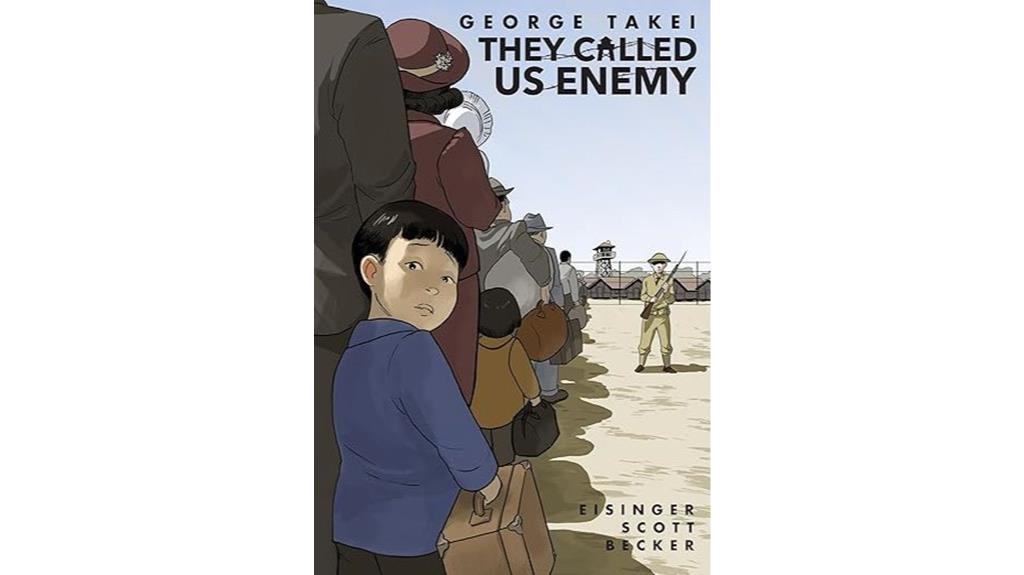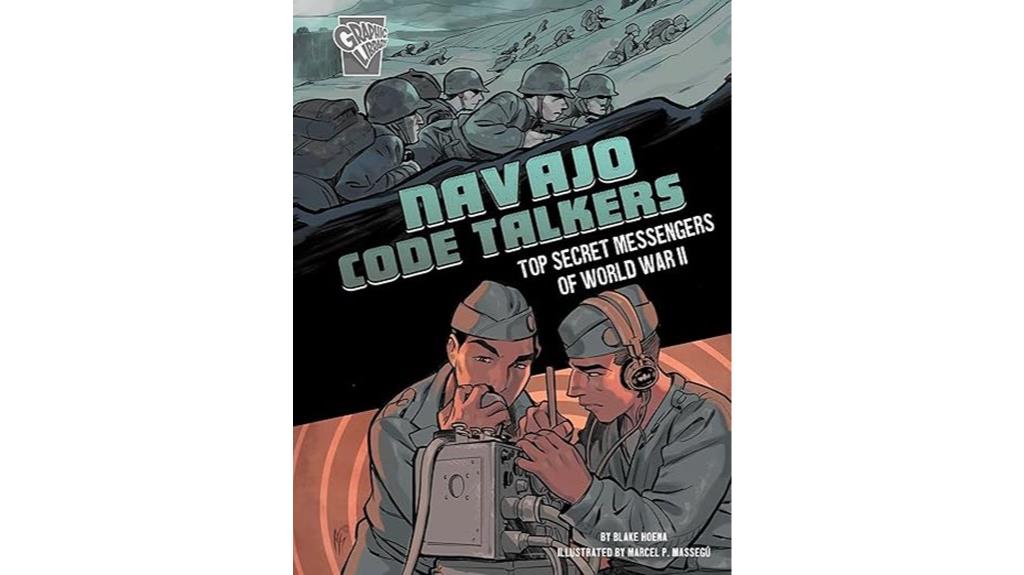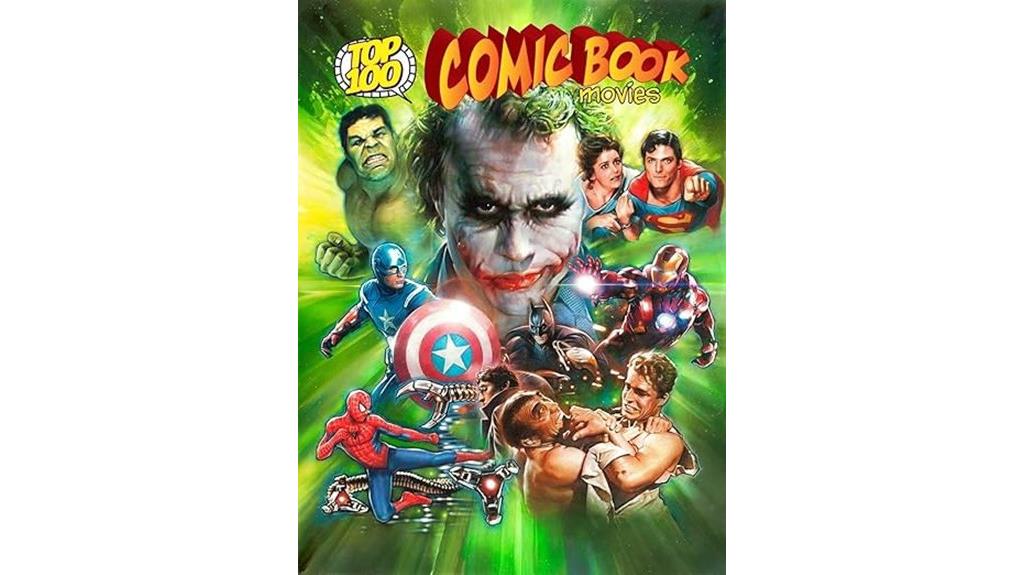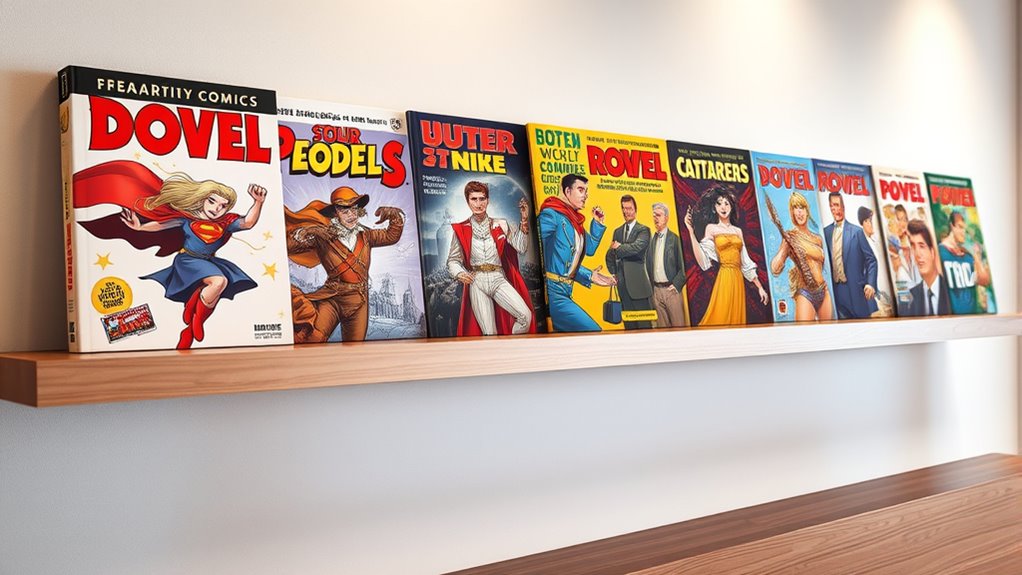If you’re looking for the best biography comic books of 2025 that truly bring history to life, I recommend exploring titles like the “March” trilogy, which vividly depicts the Civil Rights Movement with stunning artwork, and “They Called Us Enemy,” offering heartfelt stories of Japanese internment. “Radical” highlights grassroots activism with compelling storytelling, while “Navajo Code Talkers” introduces WWII secrets with engaging visuals. If you want to uncover more about powerful real-life stories, keep exploring these enthralling titles.
Key Takeaways
- The best biography comic books of 2025 feature personal stories of influential historical figures with engaging artwork and accessible narratives.
- They cover diverse topics, including civil rights, wartime resilience, political activism, and cultural icons, bringing history to vivid life.
- These comics utilize visual storytelling techniques, such as striking illustrations and simplified explanations, to appeal to a broad age range.
- Many titles are praised for inspiring curiosity and empathy, making complex historical events relatable and impactful.
- They serve as valuable educational tools for classrooms and history enthusiasts seeking immersive, visually rich biographies.
March (Trilogy Slipcase Set)

If you’re looking for an accessible yet powerful way to teach young adults and adults about the Civil Rights Movement, the March trilogy slipcase set is an excellent choice. Authored by John Lewis and illustrated by Nate Powell, it combines compelling storytelling with striking artwork influenced by African-American and manga styles. The trilogy vividly narrates Lewis’s early life, key protests, and internal debates within civil rights groups. It personalizes history, making it relevant today. The set’s quality and emotional depth make it an essential educational tool, inspiring activism and understanding of social justice issues. It’s a beautifully crafted resource that brings history to life in an engaging, meaningful way.
Best For: educators, students, and history enthusiasts seeking an engaging, insightful introduction to the Civil Rights Movement and activism.
Pros:
- Combines compelling storytelling with striking artwork influenced by African-American and manga styles, making complex history accessible and engaging.
- Provides a personal and nuanced narrative that highlights key protests, internal debates, and the moral courage of civil rights leaders.
- Serves as a versatile educational resource suitable for both young adults and adults, fostering discussion on social justice and civic engagement.
Cons:
- The detailed artwork and nuanced storytelling may require careful attention, which might be challenging for younger or less experienced readers.
- As a graphic novel series, some readers might prefer more traditional history texts for deep academic study.
- The focus on American civil rights history, though contextualized globally, may limit its appeal for those seeking broader international perspectives.
They Called Us Enemy

They Called Us Enemy is an essential read for anyone interested in understanding American history through personal stories, especially those with family ties to Japanese internment. As a granddaughter of an internment camp survivor and a Star Trek fan, I found the book deeply personal and emotionally moving. I read it in three days, unable to put it down, and was touched by its honesty. The graphic novel vividly depicts the suffering and resilience of Japanese Americans, shedding light on a neglected chapter of WWII. Its beautiful art and storytelling make history accessible, fostering empathy and reminding us of the importance of remembering past injustices.
Best For: history enthusiasts, educators, and anyone interested in personal stories of resilience and social justice related to Japanese internment during WWII.
Pros:
- Deeply personal and emotionally impactful storytelling that fosters empathy.
- Beautiful, simple illustrations that enhance understanding and engagement.
- Provides valuable educational insights into a often-overlooked chapter of American history.
Cons:
- May be too serious or intense for very young children under twelve.
- Limited humor, which could affect engagement for some readers seeking lighter content.
- Banned in certain areas, highlighting potential controversy or restrictions in some regions.
March: Book Two

“March: Book Two” stands out as an essential read for middle school students and educators seeking a powerful, visually engaging way to learn about the Civil Rights movement. This graphic novel combines compelling artwork with storytelling that highlights the bravery and sacrifices of leaders like Dr. Martin Luther King Jr. and John Lewis. The stark black-and-white imagery vividly depicts the brutality and hope of that era, making complex history accessible and emotionally impactful. It emphasizes themes of non-violent resistance, love, and perseverance, inspiring readers to reflect on past struggles and recognize ongoing battles for justice today.
Best For: middle school students, educators, and anyone interested in learning about the Civil Rights movement through engaging, accessible visuals and storytelling.
Pros:
- Vivid black-and-white artwork that powerfully conveys emotional and historical depth
- Accessible storytelling that simplifies complex social issues for young readers
- Emphasizes important themes of non-violence, love, perseverance, and social justice
Cons:
- Physical presentation and layout could be improved for easier readability
- May require background knowledge for full appreciation of some historical references
- As a graphic novel, it might not cover all aspects of the Civil Rights movement in exhaustive detail
I Killed: True Stories of the Road from Americas Top Comics

Fans of stand-up comedy and behind-the-scenes stories will find “I Killed: True Stories of the Road from America’s Top Comics” an engaging read. I was hooked by its candid, often gritty tales from comedians on tour, revealing both hilarious and heartbreaking moments. The stories cover everything from outrageous antics to personal struggles, giving a raw glimpse into the chaos behind the curtain. While some tales feel exaggerated or lose humor in writing, the collection overall showcases the perseverance and resilience required in comedy. It’s a quick, entertaining read that offers genuine insights into the highs and lows of life on the road for America’s top comics.
Best For: comedy fans, industry insiders, and anyone interested in the raw, behind-the-scenes realities of stand-up comedy touring.
Pros:
- Offers candid, authentic stories from well-known comedians that provide insight into the challenges of touring.
- Short, quick reads that are perfect for casual or on-the-go entertainment.
- Combines humor with gritty, emotional tales, making it both funny and poignant.
Cons:
- Some stories may feel exaggerated or lose humor when written down compared to live delivery.
- Includes anecdotes from less credible sources, which can affect perceived authenticity.
- The gritty and sometimes raunchy content may not appeal to all readers.

If you’re looking for an engaging way to introduce middle school students to the pivotal role of the Navajo Code Talkers during World War II, this comic book-style resource is an excellent choice. It highlights how these Navajo soldiers served as secret messengers, using their unique language to protect essential communications. Their coded messages greatly contributed to the Allied victory, making history come alive in a fun, accessible format. While some find the presentation more like a pamphlet than a detailed book, it still offers a compelling introduction to this important chapter of history, perfect for sparking curiosity in young learners.
Best For: educators seeking an engaging, beginner-friendly resource to introduce middle school students to the historical significance of the Navajo Code Talkers in World War II.
Pros:
- Provides an engaging, comic book-style format that appeals to young learners
- Highlights the important role of Navajo Code Talkers in a way that is accessible and fun
- Suitable as an introductory tool to spark interest in history and social studies
Cons:
- Format may be perceived as more like a pamphlet than a comprehensive book
- Lacks in-depth historical details and comprehensive content
- Some readers may find the presentation style disappointing or oversimplified
Top 100 Comic Book Movies

Anyone interested in a well-researched, exhaustive ranking of the top comic book movies will find Gerani’s “Top 100 Comic Book Movies” an invaluable resource. Despite a five-year delay, the book’s detailed list covers everything from 1930s serials to modern blockbusters, offering a complete view of the genre’s evolution. While rankings spark debate—like Gerani’s unconventional placement of “The Dark Knight”—the book remains influential, cited by scholars and enthusiasts alike. Its engaging visuals and insightful commentary make it a must-have for fans. Even with some minor errors and omissions of recent hits, it’s an essential guide to the cinematic world of comic book storytelling.
Best For: comic book film enthusiasts and scholars seeking a comprehensive, well-researched ranking of top comic book movies across history.
Pros:
- Exhaustive coverage from early serials to modern blockbusters
- Engaging visuals and insightful commentary that spark discussion
- Highly regarded and frequently cited in scholarly and enthusiast circles
Cons:
- Five-year publication delay resulting in some outdated omissions
- Minor factual inaccuracies and mislabeling of titles
- Rankings can be subjective and controversial among fans

Radical: My Year with a Socialist Senator is an ideal read for those who want to understand the realities of grassroots political activism through an engaging and accessible format. This graphic novel follows Senator Julia Salazar’s first year in office, revealing the challenges of reforming outdated systems and fighting corruption. The illustrations simplify complex issues like tenant laws and political maneuvering, making them relatable and easy to grasp. It highlights how committed individuals can influence change, emphasizing the power of grassroots efforts. With its compelling storytelling, it’s perfect for newcomers and seasoned activists alike, offering practical insights into steering politics and inspiring civic engagement.
Best For: readers interested in understanding grassroots activism, political reform, and the realities of local government through an engaging and accessible graphic novel.
Pros:
- Provides a clear, visually engaging explanation of complex political issues like tenant laws and corruption
- Inspires civic participation by highlighting grassroots activism and individual impact
- Suitable for a wide audience, from newcomers to seasoned political enthusiasts
Cons:
- As a graphic novel, it may lack in-depth analysis of certain policy details
- Focused on one politician’s experience, which might limit broader context
- Some readers seeking comprehensive academic or theoretical insights may find it too simplified
Factors to Consider When Choosing Biography Comic Books

When selecting biography comic books, I focus on the authenticity of the content and how well it captures the true story. I also consider the artistic style to guarantee it appeals to me and matches the audience’s age range. Finally, I look for educational value and personal relevance to make the reading both meaningful and engaging.
Authenticity of Content
Choosing a biography comic book with authentic content requires careful evaluation of how accurately it presents historical facts, personal stories, and events. I look for works that cite credible sources, interviews, and primary documents, which show thorough research. Sometimes, creators dramatize or simplify details for storytelling, but I prefer comics that maintain factual integrity. When creators collaborate with biographical subjects, historians, or experts, it adds credibility and reassures me that the content is reliable. I also consider the author’s background and the publisher’s reputation, as these factors influence the accuracy of the information. Authenticity matters because it ensures I’m learning true stories and not fictionalized versions. Ultimately, well-researched comics help bring genuine history to life in a compelling and trustworthy way.
Artistic Style Appeal
A compelling artistic style can make a biography comic book truly stand out by capturing my attention and making the story more engaging. The way colors, line work, and illustration techniques are used can evoke specific moods and highlight key moments in a person’s life. When an artist incorporates cultural aesthetics—like manga or African-American art—it deepens my connection to the subject’s background and enriches the narrative. The visual presentation also boosts emotional impact, helping me feel resilience, struggle, or triumph more vividly than words alone could. Consistency in style is essential; it sets the tone—whether serious, inspiring, or light-hearted—and shapes my overall reading experience. A well-chosen artistic style transforms biography comics into memorable, immersive stories.
Audience Age Range
Selecting the right biography comic book depends heavily on the age and maturity level of the intended audience. For young children, I recommend titles with simple language, vibrant illustrations, and themes suitable for early readers or middle-grade readers. These books should avoid complex or sensitive topics that might be confusing or upsetting. Teen and adult audiences, on the other hand, can handle more detailed storytelling, nuanced artwork, and mature themes, including challenging historical events or controversial issues. When choosing, I consider the emotional maturity of the reader, especially when depicting trauma or violence. Matching the story’s depth and themes with the reader’s cognitive and emotional development guarantees the comic book is engaging, appropriate, and educational.
Educational Value
Educational value plays a pivotal role in determining the effectiveness of biography comic books as learning tools. I look for comics that effectively use visuals to clarify complex historical and personal stories, making them accessible to different learning styles. Well-researched details, dates, and context help deepen understanding of a subject’s significance. The combination of images and text not only makes reading engaging but also reinforces memory retention. These comics can serve as excellent supplementary materials in classrooms, sparking critical thinking and discussion about social and historical issues. I also prioritize comics that present balanced perspectives, showcasing achievements alongside challenges and broader impacts. When choosing biography comics, these educational factors ensure the material is both informative and thought-provoking, enriching the learning experience.
Personal Relevance
Have you ever noticed how a biography comic becomes more compelling when it reflects your own passions or experiences? Personal relevance makes the story resonate deeply, drawing you in emotionally. When the subject’s background or achievements align with what you care about, it fosters a stronger connection and boosts your understanding. If their journey mirrors your interests or values, it can inspire motivation and admiration. This sense of personal significance sparks curiosity, pushing you to explore related topics further. Choosing a biography that feels meaningful transforms a casual read into a memorable, impactful experience. It’s not just about learning facts but about connecting with the story on a deeper level, making history come alive in ways that truly matter to you.
Frequently Asked Questions
Which Biography Comic Book Offers the Most Visually Engaging Storytelling?
I believe “History in Motion” offers the most visually engaging storytelling. The artwork is vibrant, dynamic, and perfectly captures the essence of each historical moment. I love how the panels burst with color and detail, making history feel alive. The creative use of layouts and illustrations keeps me hooked from start to finish. If you want a comic book that truly immerses you visually, this one’s a must-read.
Are There Age-Appropriate Biography Comics for Young Readers?
There are plenty of age-appropriate biography comics for young readers that make history come alive like a vivid dream. I’ve seen titles that are perfectly tailored, with simple language and colorful illustrations that capture kids’ imaginations. These comics introduce young minds to inspiring figures and fascinating stories without overwhelming them. It’s like giving children a magical window into history — fun, educational, and just right for their age!
How Do Biography Comics Balance Historical Accuracy With Artistic Interpretation?
I believe biography comics strike a balance by sticking closely to factual events while using artistic interpretation to enhance storytelling. I see creators carefully research their subjects to guarantee accuracy, but they also use visuals and stylized elements to bring emotions and key moments to life. This mix makes history engaging and relatable, helping readers connect deeply with the subject without sacrificing truth.
Can Biography Comic Books Be Used Effectively in Educational Settings?
Absolutely, biography comic books are powerful tools in education, turning learning into an adventure that can ignite students’ curiosity. I’ve seen them make complex historical events feel like a vivid story unfolding right before your eyes. They’re engaging, accessible, and spark critical thinking. When used thoughtfully, they can deepen understanding and make history unforgettable—like a time machine in comic form, bringing the past to life vividly and memorably.
What Are Emerging Trends in Biography Comic Book Storytelling for 2025?
In 2025, biography comic books are embracing innovative storytelling techniques like interactive elements, multimedia integration, and immersive visuals to engage readers. I see a trend toward blending factual accuracy with creative narration, making history more relatable and vivid. These comics often highlight diverse voices and untold stories, helping us connect deeply with historical figures. It’s exciting to witness how these trends make learning more dynamic and accessible for everyone.
Conclusion
Think of these biography comics as treasure maps, each leading me through uncharted histories and vibrant lives. They’re like windows into hidden worlds, revealing stories that shape our understanding of the past. As you explore these pages, remember you’re holding keys to access the stories that build our collective identity. Immerse yourself, and let these comics be your guiding stars on a journey through time, making history feel alive and truly yours.










